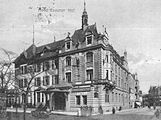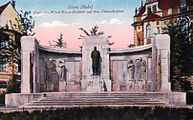Limbecker Platz
| Limbecker Platz | |
|---|---|
| Place in food | |
 The photo facing north shows today's shopping center . The actual Limbecker Platz was in the middle of its longest straight, where Limbecker Straße branches off. This means that Limbecker Platz is now partially built over with the shopping center. |
|
| Basic data | |
| place | eat |
| District | City center |
| Created | 18th century |
| Newly designed | 2009 overbuilt with shopping center |
| Hist. Names | Thomae Square (1933–1939) |
| Confluent streets | Limbecker Strasse , Friedrich-Ebert-Strasse, Logenstrasse |
| use | |
| User groups | Foot traffic |
| Space design | Pedestrian zone, partly overbuilt with a shopping center |
| Technical specifications | |
| building-costs | Last redesign in 2009: 300 million euros with shopping center |
The Limbecker place since the 18th century, a central place in the northwest of Essen city center . After it became a traffic junction towards the end of the 19th century and a pedestrian zone in the 1980s, it was largely built over in 2009 with the shopping center of the same name .
Limbecker Platz today
The Limbecker Platz shopping center opened in 2009, covering a large part of the original Limbecker Platz. Today the remaining space in front of the eastern main entrance of the shopping center, which has the postal address Limbecker Platz 1, consists of an intersection of Limbecker- , Logen- and Friedrich-Ebert-Straße that has been converted into a pedestrian zone . Before that, the Karstadt department store, formerly Althoff , was closed on March 1, 2008 . It was not a listed building , because only the facade was made of sandstone, the interior was made of reinforced concrete, which was in very poor condition due to mountain damage and therefore the house had a height difference of around one meter across the width of the side. After the demolition of the old Karstadt building including the parking garage, its 35 meter high tower was blown up on June 1, 2008 as the last part of the building.
history
prehistory
Name factor in the square and thus also for the shopping center and for the Limbecker Straße is the Linde Becke , or later Limbecke (Becke for Bach), a river that used to flow to the present location by a pond. In this so-called cancer pond, women from Essen did their laundry. In the west of the city of Essen, which was once surrounded by the city wall and moat, this river operated several mills near the Limbeck Gate (Porta Lindenbeke), first mentioned in 1323, and partially fed the moat. The Limbecke operated, among other things, the Hindenburg mill, in 1457 the hammer mill of a harness maker and in 1465 a tinder mill . In 1823 there was an oil mill with a pond here. Since all city views at that time show Essen from the east, no image material is known of the Limbeck city gate. Written traditions describe it as consisting of a main and front gate, connected by long gate cheeks. The entrance gate was built in 1418 and thus formed the last construction phase of the Essen city wall. The Limbecker Tor, in turn, gave its name to the district behind it, which at the time was most populous. Behind the gate, as today, ran Limbecker Straße up to the Marktberg with the Marktkirche . It is not known when the Limbecker Tor was demolished, but it can be assumed that it was when the city wall between Kettwiger and Limbecker Tor was torn down around 1820. In the Middle Ages, the area around the former Limbecker Tor was well below the current elevation due to the landfill. During the construction work on today's shopping center, sediments from the Limbecke with washed-in wood were found at a depth of a few meters, on which ax tracks were also discovered.
In the 19th century

Around 1859/1860 the pond in front of the Limbecker Tor was removed. Up until that time, the Essen cowherd moved daily with the cows of the citizens from the Limbecker Tor to the Segerothsweide. Around the end of the 18th century, a green area was created on Limbecker Platz, the striking fountain of which shaped the square for a long time. Around 1860 the first houses were built here as a result of the emerging industry, such as a consumer and a commercial building belonging to the Krupp family . This gave the square its current name around 1865.
On the occasion of a visit by Kaiser Wilhelm I in September 1877, a triumphal arch was built on the site of the old Limbeck Gate. During the construction of the shopping center in August 2008, parts of the Hellweg , which led through Limbecker Tor, and three brick fountains were uncovered at the place where the Althoff department store (old Karstadthaus) previously stood . They came from the second half of the 19th century, were between 10 and 14 meters deep and supplied the residents who had settled outside the city center in the course of industrialization .
From the traffic junction to the pedestrian zone
At the end of the 19th century, Limbecker Platz developed into an important transport hub. In 1893, for example, the first tram line from the main train station via Limbecker Platz to Borbeck , and five years later the tram line from Frohnhausen via Limbecker Platz to Rotthausen began operations. The line from Segeroth to Steele also ran across Limbecker Platz. The line to Borbeck was extended to both Oberhausen and Bottrop before the turn of the century .
In 1898, the Krupp private hotel Essener Hof was built at Limbecker Platz 10, which at the time was open to so-called Krupp officials, i.e. senior executives, Krupp guests, but also outside the company. Office 2 as a branch of the main post office in Essen was located at Limbecker Platz 3. Furthermore, the square developed into a commercial and leisure meeting point.
The Friedrich-Alfred-Krupp monument was erected on November 17, 1907 on Limbecker Platz. In addition to members of the Krupp family and employees, the representative Adjutant General Friedrich von Scholl, who was sent by Kaiser Wilhelm II , was present for the ceremonial unveiling . In 1937 it had to give way in its entirety to a new traffic route and was initially installed near the Erlöserkirche outside the city center. Largely destroyed in the Second World War, the still preserved bronze statue of Friedrich Alfred Krupps has been given its new place in the park of Villa Hügel to this day .
In 1910/1912, Theodor Althoff built the Althoff department store on Limbecker Platz according to plans by the architect Wilhelm Kreis and opened in autumn 1912. In 1920, through the merger of Althoff and Karstadt, the house was transferred to the newly founded Rudolph Karstadt AG . The tower of the house was redesigned in 1930/1931 by the architect Philipp Schäfer . Because of its monumental appearance, the house was popularly called Warenburg in Essen . With around a thousand employees and a sales area of around 20,000 square meters on five floors, it became the largest provincial department store in western Germany.
At the time of National Socialism , Limbecker Platz was named Thomae- Platz on May 8, 1933 , named after Gottfried Thomae, a National Socialist who was killed in clashes with communists in 1928. In World War II, all the surrounding buildings were severely damaged or destroyed. After the end of the war, the square was given its original name Limbecker Platz back on May 15, 1945 .
In 1963 the Althoff department store became the parent company of what was then Karstadt AG and was rebuilt and expanded several times until the end. In the early 1970s, the Krupp private hotel Essener Hof was demolished to make way for the Quelle department store, the building of which was the last Sinn- Leffers department store, which was demolished in mid-2006 in order to make room for today's shopping center. Since then, the oldest hotel still in operation in the city center has been called the Essener Hof . The former Limbecker Platz traffic junction was converted into a pedestrian zone in the 1980s.
photos
Entrance to the shopping center of the same name
Friedrich-Alfred-Krupp monument on Limbecker Platz around 1927
Individual evidence
- ↑ Press release from the city of Essen before construction begins
- ^ A b c d Erwin Dickhoff: Essener streets . Ed .: City of Essen - Historical Association for City and Monastery of Essen. Klartext-Verlag, Essen 2015, ISBN 978-3-8375-1231-1 .
- ^ A b T. Kellen: The industrial city of Essen in words and pictures. History and description of the city of Essen. At the same time a guide through food and the surrounding area. Fredebeul & Koenen, Essen 1902.
- ↑ Directory of the routes of the Essen trams 1983-2003. Unpublished script.
- ^ The inauguration of the Friedrich Alfred Krupp monument on Limbecker Platz , website of the city of Essen; accessed on January 21, 2020
- ↑ History of the city of Essen on Limbecker Platz ( memento of the original from January 20, 2008 in the Internet Archive ) Info: The archive link has been inserted automatically and has not yet been checked. Please check the original and archive link according to the instructions and then remove this notice.
- ↑ This is located in the southern area of the city center behind the former stock exchange, today's House of Technology
Web links
Coordinates: 51 ° 27 ′ 30 ″ N , 7 ° 0 ′ 22 ″ E




